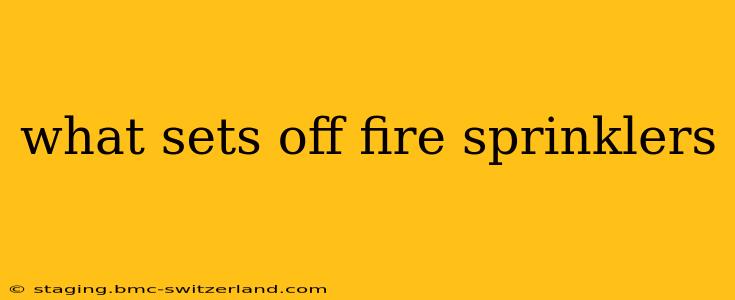What Sets Off Fire Sprinklers?
Fire sprinklers are life-saving devices designed to protect lives and property from the devastating effects of fire. Understanding how they work and what triggers their activation is crucial for building safety and preparedness. Contrary to popular belief, they don't just go off at the slightest hint of smoke or heat; they're cleverly engineered to respond to specific fire conditions. This article delves into the mechanics of fire sprinkler activation, dispelling common myths and answering frequently asked questions.
What temperature does it take to set off a fire sprinkler?
The temperature required to activate a fire sprinkler varies significantly depending on the type of sprinkler head installed. These sprinkler heads are designed with specific temperature ratings, typically ranging from 135°F (57°C) to 500°F (260°C) and higher, offering different levels of response time. Low-temperature sprinklers are frequently found in areas where a fire might develop slowly, such as warehouses, while high-temperature sprinklers are usually installed in locations with a higher potential for rapid temperature increases. The sprinkler will only activate when the temperature of the surrounding air reaches the specified rating for that particular head.
What activates a fire sprinkler?
The core mechanism behind sprinkler activation is a heat-sensitive element within the sprinkler head itself. This element, often a glass bulb filled with a liquid or a specially designed fusible link, melts or breaks when exposed to sufficient heat. This release of pressure allows water to flow from the sprinkler pipe, which is constantly pressurized, thus discharging water onto the fire. The key is that it's not just any heat; it needs to reach the threshold specific to the installed sprinkler head.
How sensitive are fire sprinklers to smoke?
Fire sprinklers are not sensitive to smoke. They are specifically designed to respond to heat, not smoke. While smoke detectors are essential for early fire detection and warning, they serve a separate and vital purpose in fire safety systems. Smoke detectors will trigger an alarm, alerting occupants to evacuate, whereas sprinklers directly combat the fire. This division of responsibility ensures that the system responds effectively and appropriately to different fire indicators.
Do fire sprinklers go off with steam?
Steam, while indicating the presence of heat, is unlikely to activate a fire sprinkler head by itself unless the temperature of the steam is high enough to melt or break the heat-sensitive element. The temperature of the surrounding air needs to reach the threshold; steam itself might not be hot enough without sufficient air temperature to trigger a sprinkler.
Can a fire sprinkler be accidentally triggered?
Accidental activation of a fire sprinkler is rare but can occur. Factors such as direct exposure to excessive heat from other sources (e.g., welding, intense sunlight, or a very hot lamp directly above), physical damage to the sprinkler head, or extremely high ambient temperatures in the room can potentially cause unintended activation. Regular inspection and maintenance of the sprinkler system minimize this risk.
How much water does a fire sprinkler use?
The amount of water discharged from a fire sprinkler depends on several factors including the type of sprinkler head, the water pressure in the system, and the size of the fire. However, individual sprinkler heads generally only discharge a limited amount of water at a time which is far less than the volume of a typical firehose and effectively targets the area of the fire directly. This precise application often keeps water damage to a minimum.
In conclusion, fire sprinklers are a crucial element of fire protection systems. Their activation is carefully calibrated to respond to specific heat levels, ensuring effective and targeted fire suppression. Understanding their mechanisms and limitations can help us better appreciate their role in maintaining building safety and minimizing fire damage. Remember that smoke detectors and sprinklers work together, providing a multi-layered approach to fire safety.
